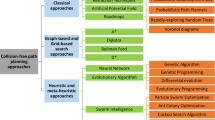Abstract
The increased complexity of the dynamics of robots considering joint elasticity makes conventional model-based control strategies complex and difficult to synthesize. In this paper, a model-free control using integrated PID-type learning and fuzzy control for flexible-joint manipulators is proposed. Optimal PID gains can be learned by a neural network learning algorithm and then a simple standard fuzzy control could be incorporated in the overall control strategy, if needed, for enhancing the system responses. A modified recursive least squares algorithm is suggested for faster learning of the connection weights representing the PID-like gains. Simulation results show that the suggested simple model-free approach can control a complex flexible-joint manipulator to meet stringent requirements for both transient and steady-state performances.
Similar content being viewed by others
References
Tomei, P.: A simple PD controller for robots with elastic joints, IEEE Trans. Automatic Control 36(10) (1991), 1208–1213.
Forrest-Barlach, M. G. and Babcock, S. M.: Inverse dynamics position control of a compliant manipulator, in Proc. of IEEE Int. Conf. on Robotics and Automation, San Francisco, 1986, pp. 196–205; IEEE J. of Robotics and Automation RA-3(1987), 75–83.
Lin, L. C. and Yuan, K.: Control of flexible joint robots via external linearization approach, J. Robotic Systems 7(1) (1990), 1–22.
Lin, L. C.: State feedback H ∞ control of manipulators with flexible joints and links, in IEEE Int. Conf. on Robotics and Automation, Sacramento, CA, 1991, pp. 218–223.
Ficola, A., Marino, R., and Nicosia, S.: A singular perturbation approach to the control of elastic robots, in Proc. of the 21st Annual Allerton Conf. on Communications, Control and Computing, University of Illinois, 1983; A composite control strategy for a weakly elastic robot, in Proc. of the 22nd Annual Allerton Conf. on Communications, Control, and Computing, University of Illinois, 1984, pp. 225–232.
Ghorbel, F. and Spong, M. W.: Adaptive integral manifold control of flexible joint robot manipulators, in Proc. IEEE Int. Conf. on Rob. and Auto., Nice, France, 1992, pp. 707–714.
Nicosia, S. and Tomei, P.: A method to design adaptive controllers for flexible joint robots, in Proc. IEEE Int. Conf. on Rob. and Auto., Nice, France, 1992, pp. 701–706.
Mrad, F. T. and Ahmad, S.: Adaptive control of flexible joint robots using position and velocity feedback, Int. J. Control 55(5) (1991), 1255–1279.
Lozano, R. and Brogliato, B.: Adaptive control of robot manipulators with flexible joints, IEEE Trans. Automatic Control 37(2) (1992), 174–181.
Hecht-Nielson, R.: Theory of the back-propagation neural network, in Proc. of the Int. J. Conf. on Neural Networks, Vol. I, 1989, pp. 593–605.
Green, M. E. and Tan, H.: Indirect adaptive control of a two-link robot arm using regularization neural networks, in Proc. Int. Conf. IEEE Industrial Electronics Society, 1991, pp. 952–956.
Ozaki, T. et al.: Trajectory control of robot manipulators using neural networks, IEEE Trans. Industrial Electronics 38(1991), 195–202.
Zeman, V., Patel, R. V., and Khorasani, K.: A neural network based control strategy for flexible-joint manipulators, in Proc. of the 28th Conf. on Dec. and Contr., Tampa, Florida, 1989, pp. 1759–1764.
Wang, L. X.: Fuzzy systems are universal approximators, in Proc. IEEE Int. Conf. on Fuzzy Systems, San Diego, 1992, pp. 1163–1170.
Yager, R. R. and Filev, D. P.: Essentials of Fuzzy Modeling and Control, Wiley, New York, 1994.
Passino, K. M.: Intelligent control for autonomous systems, IEEE Spectrum, June 1995, pp. 55–62.
Wang, L. X.: Adaptive Fuzzy Systems and Control: Design and Stability Analysis, Prentice-Hall, Englewood Cliffs, NJ, 1994.
Lin, L. C. and Chen, C. C.: Rigid model-based fuzzy control of flexible-joint manipulators, J. of Intelligent and Robotic Systems 13(1995), 107–126.
Spong, M. W. and Vidyasagar, M.: Robot Dynamics and Control, Wiley, New York, 1989.
Readman, M. C. and Belanger, P. R.: Stabilization of the fast modes of a flexible-joint robot, Int. J. Robotics Research 11(2) (1992), 123–134.
Rumelhart, D. E., Mcclelland, J. L., and the PDP Research Group: Parallel Distributed Processing, Vol. 1, MIT Press, Cambridge, MA, 1986.
Goodwin, G. C. and Sin, K. S.: Adaptive Filtering, Prediction and Control, Prentice-Hall, Englewood Cliffs, NJ, 1984.
Åström, K. J. and Wittenmark, B.: Adaptive Control, 2nd edn, Addison-Wesley, 1995.
Goldberg, D. E.: Genetic Algorithms in Search, Optimization, and Machine Learning, Addison-Wesley, 1989.
Armstrong-Helouvry, B.: Stick-slip and control in low-speed motion, IEEE Trans. Automatic Control 38(10) (1993), 1483–1495.
Lin, L. C.: Nonlinear precision motion control of machines with the effects of flexibility and stick-slip–A case study for flexible-joint manipulators, R.O.C. National Science Council Research Report, NSC 84-2212-E-005-024, 1995.
Author information
Authors and Affiliations
Rights and permissions
About this article
Cite this article
Lin, LC., Lee, TE. Integrated PID-type Learning and Fuzzy Control for Flexible-joint Manipulators. Journal of Intelligent and Robotic Systems 18, 47–66 (1997). https://doi.org/10.1023/A:1007942528058
Issue Date:
DOI: https://doi.org/10.1023/A:1007942528058




